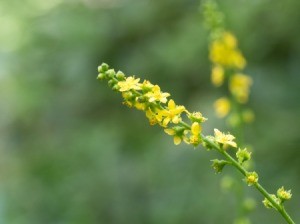
Botanical Name:
Agrimonia eupatoria
Common names:
Agrimony, Church Steeples, Cockeburr, Sticklewort and Philanthropos.
Description:
Modest and almost weed-like in appearance, Agrimony is an aromatic plant with one or more stems supporting tall, slender spikes of flowers and a few weak branches. All parts of this plant are aromatic, smelling slightly like apricots. Agrimony grows wild in the United States and parts of Europe.
Life Cycle:
short-lived perennial
Exposure:
full sun to partial shade
Cultivation:
seeds require cold and should be sown in late winter.
Propagation:
seeds or cuttings
Parts Used:
flowers, leaves and roots; entire herb has a hint of apricot fragrance
Harvesting and Storage:
Cut flowers just as they start to open. Cut leaves as needed and hang to dry.
Medicinal Uses:
In ancient times, Agrimony was widely used for healing wounds on the battlefield. Its main medical action is that of a mild astringent. Due to its high silica content, agrimony is considered an excellent remedy for diarrhea (especially in small children) and skin eruptions such as pimples and blotches. It makes and excellent gargle for laryngitis and has a bitter tonic action on the liver.
Culinary Uses:
none
Other Uses:
perennial borders and native plantings; the entire plant contains a yellow dye that can be used to color wool
Notes:
Other similarly named herbs (water agrimony and hemp agrimony) are not related botanically but were so named because they share some of the same properties.
